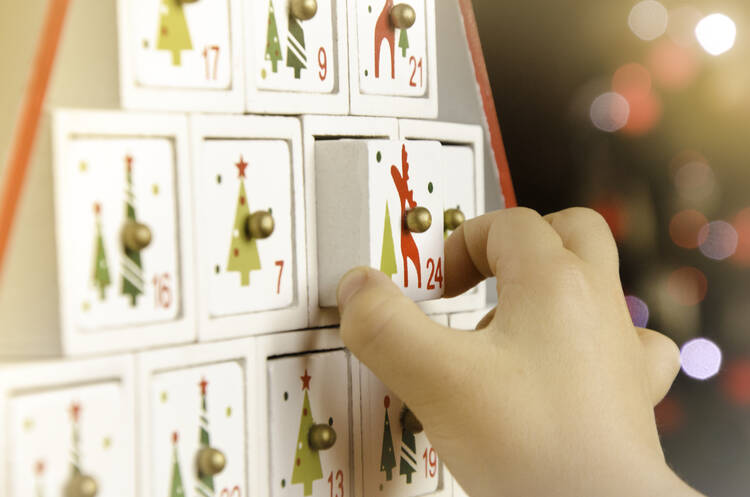They arrived on our doorstep every year, without fail. My mother’s friend, Kathleen, began sending Advent calendars to me and my siblings when we were children, and the tradition continued well into our adulthoods. They were colorful cardstock, often with images of the nativity highlighted in silver glitter or a snowy village scene decorated with the same. We were thrilled to open the door each day and find a tiny painting of an angel or a candy cane or a drum. We’d hold the calendar’s open squares up to a light and let it shine like a stained glass window of a miniature church. On our favorite ones, the little door also had a Scripture quote inside, a line-by-line telling of the infancy narrative told over 24 days, like the analog equivalent of a Twitter thread.
It was years until I learned about the chocolate ones. This seemed like a natural upgrade, but my mother was not a fan, perhaps because she feared having to turn down requests for chocolate for breakfast for 24 days in a row. When compared to cardboard doors, they seemed wildly extravagant, but I’ve always thought that the chocolate Advent calendars still spur the spirit of the season by offering a small, sweet reminder of something even sweeter to come.
This much-maligned calendar has also sparked a Scrooge-like feeling in me, although for different reasons than the TikTok viewers.
I’m not sure I can say the same for the $825 Chanel Advent calendar currently sparking outrage on the internet. A TikTok unboxing of the calendar, which comes in the traditional Christmas shape of a bottle of Chanel No. 5, put the contents on display for viewers, who expressed some satisfaction with the various Chanel cosmetics but shock and disdain for items like stickers and a dust bag. (As someone who stores all my bags in a heap on my closet floor, I had to Google this to learn that a dust bag apparently is a not-fancy bag used to store fancy bags.) The internet is angry because spending $825 for a set of items clearly worth a fraction of that price seems like a bad deal. I agree.
Maybe it’s the fact that the Chanel calendar was released to celebrate the birthday of a perfume (happy 100th, Chanel No. 5) rather than sweet baby Jesus. Or maybe it’s the fact that the Chanel calendar numbers go from 5 to 31 (the alpha and the omega of perfume branding?). But this much-maligned calendar has also sparked a Scrooge-like feeling in me, although for different reasons than the TikTok viewers. And this feeling has sent me doom-scrolling through other examples of what I can only describe as the bizarre, hyper-commercialization of a seasonal tradition that has moved very far from its origins.
In the early 1900s, German Protestants made chalk lines on walls or lit a candle to mark each day of the Advent season. Later they moved on to hanging daily devotional images. The creation of the modern traditional calendar is attributed to Gerhard Lang, who was the first to add those essential tiny doors over the images.
Today, more and more Advent calendars seem aimed at adding to product lines rather than counting down to Christmas. You can buy at least four different types of Lego Advent calendars. There are Advent calendars featuring characters from Friends (offering surprises like a “Friends-inspired recipe card”?) and ones that offer daily bottles of beard oil (maybe some smell like frankincense or myrrh?). The Dolly Parton Christmas line at William and Sonoma includes this sweet-filled Advent Calendar. (Though it has also sparked protests—because it was deemed insufficiently grand for her justifiably legendary status.) There is a Fancy Feast Advent calendar for cats and a Trader Joe’s Advent calendar for dogs. You can buy ones with 24 days of wine or tea. And then buy one featuring oral care products to take care of the wine and tea stains. The list is seemingly endless.
More and more Advent calendars seem aimed at adding to product lines rather than counting down to Christmas.
And for those seeking better value for their money from a luxury Advent calendar, Tiffany has produced an Advent calendar that is an actual wooden cupboard that houses “the 24 most extraordinary gifts of the season.” With a price tag of $150,000, one can assume that it does not include stickers.
To be clear, I’m not normally a stickler for how to celebrate this liturgical season. Our house has both a Jesse Tree and a Christmas tree, an Advent wreath on our table and a Christmas wreath on our front door. My kids fight over who gets to move a plastic Christmas light bulb to the next numbered pocket on our quilted Winnie the Pooh Advent calendar, which they convinced me to buy at a parish craft fair.
I also know that perfectly holy people might choose to buy an Advent calendar for a dog, and a mean-spirited person might be among the first to buy a Scripture-based Advent calendar. And who am I to say that someone building one Lego character a day for 24 days can’t serve as a reminder to build the kingdom of God? But the Chanel and Tiffany calendars have left me feeling like we could all benefit from hitting reset on our Advent observances and, going forward, err more on the side of chalk lines than chocolate.
A prayerful Advent moves us away from asking, What am I owed today? It instead encourages us to wonder, What do I owe to others?
A tradition that started as a chance to meditate on what matters has turned into a crass brand marketing scheme that not only ignores the religious meaning of Christmas but the broader, secular understanding of the season—as one of generosity and peace—as well. If the most extraordinary gift of the season is, in fact, in one of those Tiffany blue boxes, our society is in deep, deep trouble.
Ideally, the main focus of an Advent calendar is not trying to turn one day of presents into 25. In fact, part of the point of Advent is to remind us that we can’t always get everything we want right now. That the world is sometimes dark and cold, and that thing we long for is not yet here. (On that front, maybe the Chanel calendar hits the mark.) Not every door opens for us right away.
But the other part is hope. Advent reminds us that our lives are not simply transactional. A prayerful Advent moves us away from asking, What am I owed today? It instead encourages us to wonder, What do I owe to others? It reminds us that each of us holds value far greater than we can ever imagine and that we are recipients of an extravagant love. An Advent calendar can help to offer that reminder. But the truth is that even my favorite glittery cardboard ones are not required. All we have to do is to deeply, truly believe that we are children of this loving God, who is capable of granting us peace and protecting us from all anxiety, all while we wait in joyful hope for the coming of our Savior. It’s not a bad deal.








